
|   |

|   |
Memories - Padma Jayaraj e-mail: padmajayaraj@gmail.com November 23, 2021 Alapuzha, a sleepy town in Kerala, once famous as the Venice of the South is the scene of the Art show that features the works of 267 artists hailing from Kerala, and yet scattered all over the world. Conceptualized and curated by Bose Krishnamachari, the Kochi Biennale Foundation exhibits a large scale contemporary art survey spread over five venues. Here is a collective venture, where each individual artist gets space to display the unique feature of his/her art practice. Here is a platform that showcases contemporary art practices and aesthetics to the Indian public. The ongoing exhibition is an opportunity to know the myriad things that happen all over the world through the lens of a group of Kerala's artists. 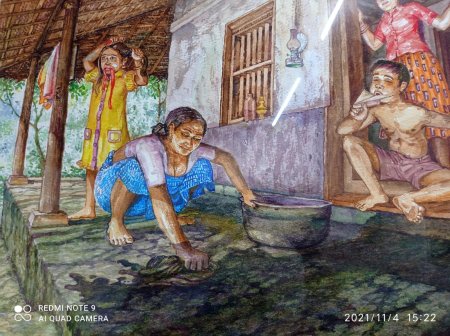

It is a revelation to know and understand concepts that spring from the clash of thoughts and ideas. All through art history, we see human perceptions change. Contemporary ideas that have evolved from human thinking, experience, and effort, in other cultures have liberated mankind all through human narration. Art has played a major role in highlighting new ideas, opening new vistas. And here is the place where we come across probing questions, disturbing ideas that cry for a change in our outlook. One morning, I wandered through a major venue in the beach area. Dazed and shaken while encountering truths behind the known and the unknown, iconic ideas faltered and fell as they stand deconstructed, like the naked Emperor. Art exposes the dark middle of the moon is the experience of any art lover. One needs to stay here for a week at least, spend time to watch, ruminate, and meditate in silence on some of the pieces. Some of the artists whose work I have studied and written earlier have undergone a sea change in their perceptions. The feminist approach reveals different aspects of truth. By afternoon, my reeling mind came across something fresh that lay like a familiar terrain. The venue, part of an old coir factory, displays another set of art and artifacts. I wandered along a veranda from the main hall, and a series of five steps took me down to a smaller room. Here is a series of watercolor paintings on the wall, not spectacular, rather unassuming, yet so inviting. And as I moved along, my soul took wings to fly back in time. To reach a vista that opened the small and simple annals of my childhood days in the rural heart of a bygone Kerala. 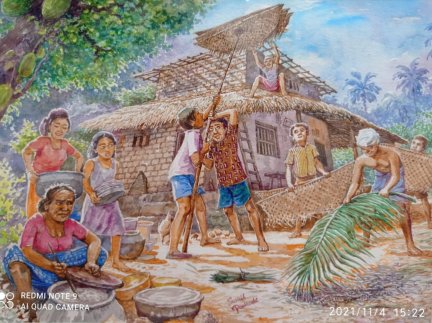
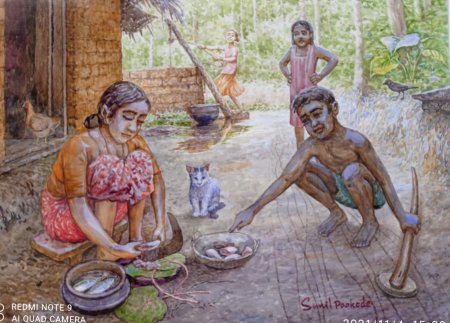
A collection of watercolor paintings, each reminded me of a happy time, filled me with nostalgia, and simply transported me back to a lost horizon. Half a century back the land of my childhood was rural in ambience. Even statehood came later. Children of my days lived in small houses built using locally available materials. As in one of the paintings, changing the thatched roof with newly woven palm leaves is an annual event in summer that children participated in with gusto. Each member had something to do. And in the evening there was sweet pudding for all. Environmentally friendly houses before tile factories and later terraced roofs, is a forgotten feature now. The painting of a woman cleaning fish while the cat sat waiting and kids playing around, reminded me of my grandmother. Those were times when we ate whatever was locally available, and shared seasonal vegetables and fruits among the neighbors. It was a life lived in harmony with Nature. Taking a bath in a water body, morning and evening, was not a ritual connected with temples for ordinary folk. For kids, as in the painting, it was just fun-filled, joyous moments, not even a water sport. While mothers washed clothes and bathed, children played on the plentiful water ponds or brooks amidst vast paddy fields. School was fun with friends than a place to learn lessons for exams. Going to school and coming back home determined the friends. As in the painting, twilight prayer was a ritual. Seated around the lighted lamp children recited slokas from gurus. It was study time too. The names of the days of the week and Malayalam months, in a sing-song style reverberated through the darkening twilights. 
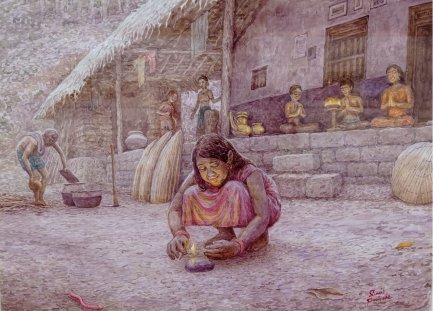
At another level as I moved along, the paintings recreated my own memories. I got drowned in nostalgia. My plight as a girl highlighted a different scene. We were more confined to the home environment, under the gaze of elders, not allowed to wander afar. We played different games. We collected seeds that looked like colored beads, feathers of birds, broken pieces of glass bangles with which we made artifacts. We loved to celebrate festivals. Thiruvathira, exclusively for women is still colorful in rural Kerala. Dressed up in new clothes, jingling glass bangles we giggled for no reason. Anything and everything brought us such delight in those days of rustic simplicity. Paintings of rural life have been evocative all along. Besides its rustic simplicity, it evokes personal memories. And that has been the added charm for any art lover. You move along the display of paintings, enjoying its beauty, its content, and your mind on a parallel trail views another film shot and kept in its archives. So here is a double delight, the real and the evocative. 
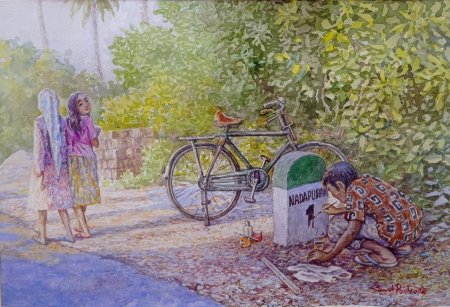
The bunch of paintings displayed pushed me to look for the artist. There was just the name...Sunil Pookode, based in Kuwait. No bio data, no artist's statement. I became curious. The Internet has plenty of information about the artist and there are more of his paintings, all done in watercolor with the perennial theme of rural children of Kerala. Childhood, through changing times, has changed from generation to generation. As an artist hailing from Kerala, Sunil Pookode has confined himself to the cultural milieu of rustic simplicity of Kerala. In another sense, his work is a pictorial rendering of the social history of Kerala's enduring childhood changing with the times. The choice of watercolor with the style of a child's rough drawing suits the theme. One cannot imagine another mode and a different medium, for the simple chronicles of the children of Kerala. 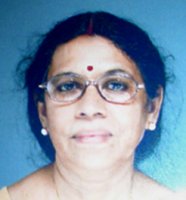 Padma Jayaraj is a freelance writer on the arts. |